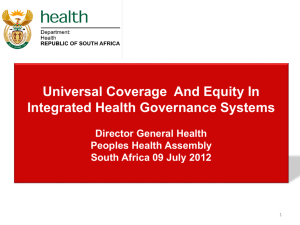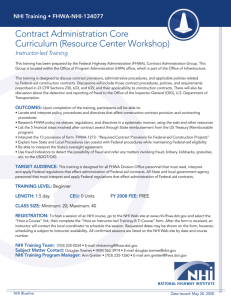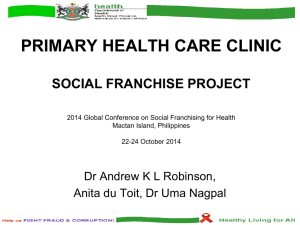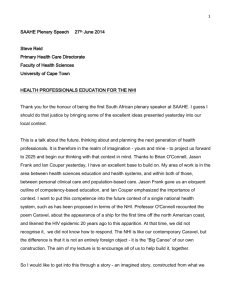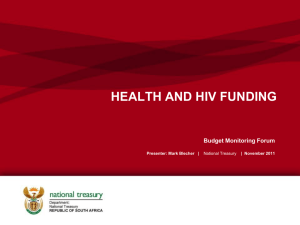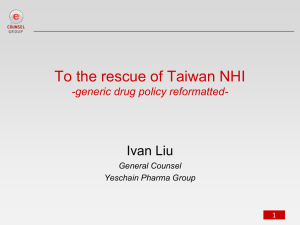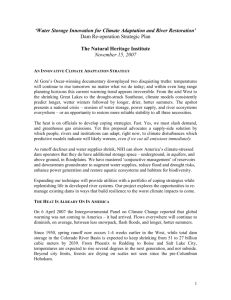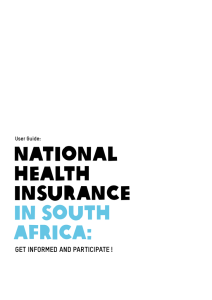presentation on national health insurance policy for the portfolio
advertisement
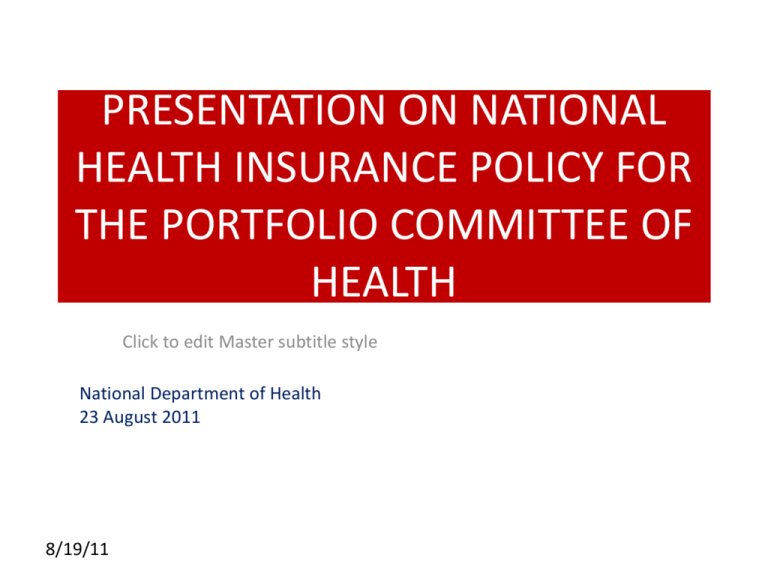
PRESENTATION ON NATIONAL HEALTH INSURANCE POLICY FOR THE PORTFOLIO COMMITTEE OF HEALTH Click to edit Master subtitle style National Department of Health 23 August 2011 8/19/11 OUTLINE • • Introduction Problem Statement: Key Health Sector Challenges • Public Sector • Private Sector • Principles of NHI • Objectives 8/19/11 INTRODUCTION...../1 • • • Introduction of an innovative system of healthcare financing Far reaching consequences on the health of South Africans Ensures that everyone has access to health services that are: • appropriate • efficient 8/19/11 INTRODUCTION......./2 • • Improve service provision Promote equity and efficiency to ensure all South Africans have access to affordable, quality healthcare services regardless of their socio-economic status 8/19/11 INTRODUCTION......./3 • • SA health system inequitable.............with the privileged few having disproportionate access to health services Recognition that this system is neither rational nor fair Current system of healthcare financing is two- • 8/19/11 INTRODUCTION......./4 • Private Sector: • • • covers 16.2% of the population relatively large proportion of funding allocated through medical schemes, various hospital care plans and out of pocket payments provides cover to private patients who have purchased a benefit option with a scheme of their choice or as a result of their employment conditions 8/19/11 INTRODUCTION......./5 • Public Sector: • Covers 84% of the population • funded through the fiscus • Poor management systems and oversight esp hospitals • • under-resourced relative to size of population that it serves and the burden of disease less human resources than the private sector – longer waiting times and lower clinical consultation time – increased risk of error 8/19/11 INTRODUCTION......../6 • To successfully implement a healthcare financing mechanism that covers the whole population such as NHI, four key interventions need to happen simultaneously: • • a complete transformation of healthcare service provision and delivery; the total overhaul of the entire healthcare system the radical change of administration and management 8/19/11 • PROBLEM STATEMENT • The 2008 World Health Report of the WHO details three trends that undermine the improvement of health outcomes globally, namely: • • Hospital centrism, which has a strong curative focus Fragmentation in approach which may be related to programmes or service delivery Uncontrolled commercialism which undermines principles of health as a public good 8/19/11 • KEY CHALLENGES IN THE HEALTH SYSTEM • Quadruple Burden of Disease • Quality of Healthcare • Distribution of Financial and Human Resource • High Costs of Health Care • Out-of-pocket payments and co-payments 8/19/11 QUALITY IN PUBLIC HEALTH FACILITIES • Cleanliness • Safety and security of staff and patients • Long waiting times • Staff attitudes • Infection control Drug stock-outs • 8/19/11 EXORBITANT COSTS OF HEALTH CARE IN SOUTH AFRICA (PUBLIC AND PRIVATE) • • Cost of Private Health Care out of control at the expense of members of medical schemes Cost of Public Health Care escalating at the expense of the fiscus 8/19/11 1212 WHAT DRIVES THE COSTS IN THE PUBLIC SECTOR? 5 Major identifiable areas: 1. Compensation of employees 2. Pharmaceuticals 3. Laboratory Services 4. Blood and Blood products 5. Health Technology / Equipment 8/19/11 1313 Trends in Total Benefits Paid, 1997 - 2005 8/19/11 Source: Council for Medical Schemes … THE COST DRIVERS ARE HOSPITALS AND SPECIALISTS… 8/19/11 AFFORDABILITY OF MEDICAL SCHEME CONTRIBUTION • • A number of medical schemes have collapsed, been placed under curatorship or merged Schemes have reduced from over 180 in the year 2001 to about 102 in 2009 To sustain their financial viability, schemes tend to increase premiums at rates higher 8/19/11 • THE EVOLUTION OF HEALTH CARE FINANCING IN SOUTH AFRICA • • • • • • Commission on Old Age Pension and National Insurance (1928) Committee of Enquiry into National Health Insurance (1935) National Health Service Commission (1942 – 1944) Health Care Finance Committee (1994) Committee of Inquiry on National Health Insurance (1995) The Social Health Insurance Working Group (1997) • Committee 8/19/11 of Inquiry into a Comprehensive Social PRINCIPLES OF THE NHI • • • • • • • • The Right to Access Health Social Solidarity Equity Effectiveness Appropriateness Effectiveness Efficiency Affordability 8/19/11 1818 OBJECTIVES OF NHI • • To provide improved access to quality health services for all South Africans irrespective of whether they are employed or not To pool risks and funds so that equity and social solidarity will be achieved through the creation of a single fund 8/19/11 SOCIOECONOMIC BENEFITS • • • Increased output as a healthy person works more effectively and efficiently and devotes more time to productive activities (i.e. fewer days off, longer work life span); Broader knowledge base in the economy as the gains to education increase as life expectancy increases; Increased “work life” and savings as a result of increased life expectancy may result in earning and saving more for retirement; 8/19/11 2020 CONSIDERATIONS FOR ACHIEVING UNIVERSAL COVERAGE-DIMENSIONS Source: WHO (World Health Report: 2010) 8/19/11 2121 POPULATION COVERAGE • • All South Africans and legal permanent residents will be covered Short-term residents, foreign students and tourists required to obtain compulsory travel insurance • produce evidence of this upon entry into South 8/19/11 HEALTH SYSTEM REENGINEERING Primary health care services shall be delivered according to the following three streams: • • District-based clinical specialist support teams supporting delivery of priority health care programmes at a district School-based Primary Health Care services 8/19/11 • Municipal Ward-based 2323 Primary Health Care Agents DISTRICT CLINICAL SPECIALIST SUPPORT TEAMS • To address high levels of maternal and child mortality and to improve health outcomes The teams will based in districts and include: 8/19/11 • SCHOOL HEALTH SERVICES • • Delivered by a team that is headed by a professional nurse Services will include health promotion, prevention and curative health services that address the health needs of school-going children, including those children who have missed the opportunity to access services such as child immunization services during their pre8/19/11 MUNICIPAL WARD-BASED PRIMARY HEALTH CARE AGENTS • • • A team of PHC agents will be deployed in every municipal ward At least 10 people will be deployed per ward. Each team will be headed by a health professional depending on availability Each member of the team will be allocated a certain number of families 8/19/11 • MUNICIPAL WARD-BASED PRIMARY HEALTH CARE AGENTS • The teams will collectively facilitate community involvement and participation in: • • Identifying health problems and behaviours that place individuals at risk of disease or injury Vulnerable individuals and groups Implementing appropriate interventions from the service package to address the behaviours or 8/19/11health problems • HEALTHCARE BENEFITS • Primary health care services: • prevention, • promotion, • curative, • • community outreach and community-based services as well as school-based services Inpatient and outpatient hospital care (including specialist and rehabilitation 8/19/11 services) HOSPITALS BENEFITS • As part of the overhaul of the health system and improvement of its management, hospitals in South Africa will be re-designated as follows: • District hospital • Regional hospital • Tertiary hospital • Central hospital 8/19/11 • Specialized hospital ACCREDITATION OF PROVIDERS • • Draft Bill on Office of Health Standards Compliance (OHSC) will soon be tabled in Parliament An independent OHSC to be established with 3 units: • Inspection • Ombudsperson, • Certification of health facilities 8/19/11 PAYMENT OF PROVIDERS • • At PHC Level: Risk-adjusted per capita payments for accredited and contracted public and private providers At Hospital level: Global Fee with a move to Case-based payment mechanisms as an alternative to fee-for-service with a strong focus on cost containment 8/19/11 UNIT OF CONTRACTING • District Health Authority will be given the responsibility of contracting with the NHI • supported by the NHI Fund’s sub-national offices to manage the various contracts with accredited providers monitor the performance of contracted providers 8/19/11within a district • PRINCIPAL FUNDING MECHANISMS • Combination of sources: fiscus • • • employers • individuals Revenue base to be as broad as possible: • to achieve the lowest contribution rates 8/19/11 • generate sufficient funds to supplement the Role of Co-payments • Co-payments will be levied under the following circumstances: • • Services rendered not in accordance with NHI treatment protocols and guidelines Health care benefits not covered under the NHI benefit package (e.g. originator drugs or expensive spectacle frames) Non-adherence to the appropriately defined referral 8/19/11 system • INDICATIVE COSTS OF NHI Year Non-AIDS services AIDS services Other services Direct NHI Costs Total Costs Modelled 2012 57 17 42 8 124 2015 74 26 46 9 156 2020 112 37 52 13 214 2025 149 45 54 7 255 8/19/11 3535 THE ROLE OF MEDICAL SCHEMES • Medical Schemes will continue to exist side by side NHI • May also provide top up cover • No one will be allowed to opt-out of NHI 8/19/11 PILOTING OF NHI IN 2012 • • • • The first steps towards implementation of National Health Insurance in 2012 will be through piloting. 10 districts will be selected for piloting. NDOH conducting audits of all healthcare facilities Criteria of choosing these 10 districts will be based on the results of the audits as well as the 8/19/11 demographic profiles and key health indicators PREPARING FOR NHI • CEO Assessments • Designation of Hospitals • Revenue retention • PHC Re-engineering • District Health Profiles • Health Facility Audits Provincial Quality Plans •8/19/11 3838 PREPARING FOR NHI • • • Regulations to be drafted to define levels of hospitals and the appropriate skills requirements to manage hospitals / public health facilities Ministerial Task Team to advise on District Specialist Teams led by Chair of Confidential Inquiries into maternal, neonatal and under 5 deaths Audit of Community Health Workers has been 8/19/11 3939 PREPARING FOR NHI Job Description -Population Focused Specialists (All levels and all facilities in catchment area) • • • Quality of health care for mothers, newborns and children Equitable access Coordinate, monitor, supervise and support MNCH services 8/19/11 4040 PREPARING FOR NHI • In 2010 there were 150,509 registered health professionals in South Africa. From 1996 – 2008 there was a stagnation in growth of health professionals and a decline in key categories such as specialist and 8/19/11 4141 specialist nurses. • PREPARING FOR NHI • • Filling currently listed public sector vacancies would cost billions. Staffing requirements should be based on service plans informed by norms and needs. It is evident that South Africa has a nurse based health care system with 80% of health professionals comprising nurses. 8/19/11 4242 • PREPARING FOR NHI • • • Education output of most professions has been stagnant for the past fifteen years. Faculty output of MBChB graduates is not a full capacity for all faculties, and varies in quality for all professions. Budget cuts in the 1990s led to a 8/19/11 4343 Data Mapping for District Health Profiles • • Data has been collected to develop profiles of health districts, for selection and prioritization for piloting Following dimension have been applied: • Demographic • Socio-economic • Epidemiology/ Health Status Service delivery 8/19/11 • 4444 4 Groups of indicators used District management functionality self assessment. 5 Sections: 1. Service delivery platform 2. District management team 3. Other management functions 1. 2. 8/19/11 Financial management Governance and community participation Health information Staffing District office infrastructure 4545 4 Groups of indicators used 10 Socio-economic indicators Deprivation Index District Health Barometer (DHB) 2007 2. Population with private medical insurance rate (Household Survey 2007) 3. Unemployment rate 1. 8/19/11 4646 4 Groups of indicators used 10 Health Outcome (MDG proxy) indicators 1. 2. 3. 4. 5. 6. 7. 8. 9. 8/19/11 HIV prevalence (Antenatal survey 2009) TB cure rate 2008 (ETR.Net) Weighing rate 2010 (DHIS) Diarrhoea incidence 2010 (DHIS) Severe malnutrition 2010 (DHIS) Pneumonia incidence 2010 (DHIS) Measles 1st dose coverage 2010 (DHIS) Antenatal coverage 2010 (DHIS) Delivery in facility 2010 (DHIS) 4747 4 Groups of indicators used 6 Service delivery indicators 1. Cost per PDE district hospitals 2008/09 (DHB) 2. PHC expenditure per capita 2008/09 (DHB) 3. PHC (non-hospital expenditure) per patient visit 2008/09 (DHB) 4. PHC utilisation 2010/11 (DHIS) 5. PHC utilisation under 5 years 2010/11 (DHIS) 6. PHC supervision 2010/11 (DHIS) 8/19/11 4848 PREPARING FOR NHI Methodology (first 3 groups) • • District and provincial profiles have been developed Districts were ranked from best to worst performing for the 26 selected indicators and a score from 1-52 given where 1 is best performing district and 52 the worst. Where districts have the same value the same 8/19/11 score was given resulting in the last4949 value is • PREPARING FOR NHI 8/19/11 5050 Total scores and ranking across all districts socio-economic indicators Best 8/19/11 Worst 5151 Total score and ranking health service and utilisation indicators 8/19/11 5252 PREPARING FOR NHI • • Audit Scope HST led consortium appointed to audit all public health facilities; • Infrastructure • Equipment • HR • Finance management • Services 8/19/11 provided PUBLIC HEALTH FACILITIES Province PHC District Hospital Regional Hospital Specialised Hospital Tertiary Hospital Central Hospital Total EC 808 45 2 18 6 1 880 FS 280 25 5 4 1 1 316 GP 421 10 12 6 0 4 453 KZN 591 37 12 18 2 2 662 LP 463 31 5 3 2 0 504 MP 305 23 3 5 2 0 338 NC 212 18 2 3 0 0 235 NW 363 18 4 2 0 0 387 WC 282 34 5 11 1 2 435 TOTAL 8/19/11 3825 241 50 70 14 10 4210 PROGRESS Province Provincial Total Completed Completed Estimate June 2011 July 2011 Completion date EC 880 78 140 May 2012 FS 316 42 109 Feb 2012 GP 453 26 94 Feb 2012 KZN 662 59 135 April 2012 LP 504 6 64 March 2012 MP 38 18 73 Feb 2012 NC 235 120 161 Sept 2011 NW 387 28 93 March 2012 WC 435 0 7 April 2012 TOTAL 4210 337 876 9% 21% TOTAL % 8/19/11 ESTIMATED COMPLETION RATE – 2011/12 MONTH NUMBER % August 1378 33% September 1794 43% October 2175 52% November 2556 61% December 2927 70% January 3318 79% February 3698 88% March 3962 94% April 4136 98% May 4210 100% 8/19/11 PILOTING OF NHI • Additional districts will be determined on an annual basis for inclusion in the roll out. Aspects for inclusion: • Re-engineered PHC streams • Basic infrastructure • Compliance with standards • Functionality 8/19/11 of districts and facilities including THE FIRST 5 YEARS OF NHI • • NHI will be phased-in over a period of 15 years Will include piloting and strengthening the health system in the following areas: • Management of health facilities and health districts • Quality improvement • Infrastructure development 8/19/11• Medical devices including equipment Thank You 8/19/11 5959 59
